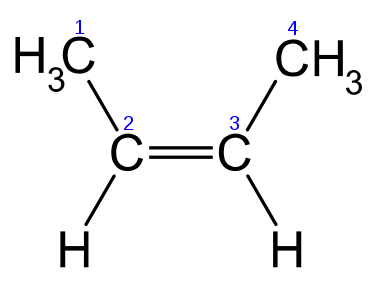As we know
by now (or should know), carbon can form double or triple bonds with other
carbon atoms. When there are only single bonds present, it is considered a saturated compound,
because all possible bonds are bonded to other atoms. On the other hand, double
or triple bonds, present in alkynes and alkenes, are unsaturated. When there
are multiple bonds, fewer hydrogens are attached to the carbon atom.
The rules
for naming alkenes and alkynes are almost identical.
However, remember this: The position of the double/triple bonds always has
the lowest number and is put in front of the parent chain. For example, in
the photo below:
This
molecule consists of four carbons. The double bond occurs at 2.
Therefore, this is 2-butene.
Let's
review some of the rules, just in case:
- Find the longest, appropriate parent chain
- Number the base chain so that side chains have the lowest total value
- Name each side chain
- Add some numbers
- List the side chain alphabetically (if you encounter the same letter, then the one with the lowest number takes precedence)
- If you have two or more double/triple bonds present, you will need to add a multiplier right before the '–ene'/'-yne' ending.
That is
it! Let's try one:
Name this:
Let's
count the parent chain: It consists of four carbons.
Lowest
numbering of alkenes: 1,3
Therefore,
this is: 1, 3 butadiene
There are
also these fancy structures that go by the name of –cis and –trans. This
applies only to alkene groups, specially butene (but not restricted to it).
If the
adjacent carbons are on the same side, then its cis ___. If it’s on the
opposite sides, it is trans ____. There is also a possibility that it is
neither cis nor trans. How does that look? Well, try it out yourself.
Posted by Andrew.




No comments:
Post a Comment